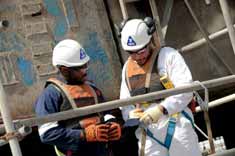
Improving energy efficiency is among the primary concerns of bulk carrier fleet owners and operators today. Despite volatile fuel prices and the costs of compliance with pollution regulations, owners are able to take advantage of a number of measures that can help improve the efficiency of their vessel operations.
Performance of the ship’s hull and propeller begins to deteriorate soon after the vessel leaves the shipyard and manifests itself in the form of increased resistance and loss of propulsion power. Owners are able to measure increases in resistance due to hull and propeller condition using a monitoring programme that also can drive decisions around in-service maintenance and dry-docking.
A planned hull maintenance schedule can be based on a variety of performance indicators, including information drawn from ship’s particulars, engine shop test results, operational data and a list of major maintenance events including dry-docking and hull cleaning.
A full monitoring programme can monitor and report on:
- the effects of marine growth and roughness (resistance) caused by fouling, corrosion and coating defects;
- ship resistance as a function of ship type, main dimensions, anti-fouling paint, draught/trim and speed;
- propeller power and thrust as a function of diameter, number of blades, area ratio and pitch ratio; and
- wind and wave resistance as a function of wind speed and direction, and wave height and direction.
A performance indicator for a ship’s propulsion efficiency can be derived from the additional power required to propel a vessel at a given reference speed in comparison to the newbuild sea trial situation, including information drawn from the vessel’s noon report and automatic log.
The resistance increase (expressed as a percentage of the total resistance, design draft and speed) describes the changed condition of the hull and propeller and typically due to hull degradation, fouling and sliming.
In terms of mitigation, owners have an increasing range of options for cleaning critical hull and propeller components. These include:
- full or spot blast treatment of the ship’s hull;
- upgrading/replacement of coatings systems; and
- propeller polishing.
Performance monitoring is necessary to improve the operational and technical efficiency of the vessel and is a pre- requisite for condition-based maintenance of hull and propeller. To support clients in making their vessels as efficient as possible, ABS offers a hull and propeller monitoring service which provides a simple and robust method for continuous and consistent performance monitoring.
BETTER LIFECYCLE PERFORMANCE THROUGH RELIABILITY CENTRED MAINTENANCE
As a logical evolution from planned machinery maintenance routines, the application of reliability-centred maintenance (RCM) allows maintenance to be evaluated using a risk-based approach that provides the most value to an owner or operator.
RCM analysis allows an owner to optimize maintenance programs by first identifying functional failures within machinery systems that have the highest risk and then determining the optimum maintenance tasks and strategies that mitigate such potential failures. In this way, maintenance programmes are created which focus on critical components and the proper maintenance strategies.
Bulk carrier operators already are adopting procedures that promote a life cycle integrity approach to vessel maintenance. By applying RCM principles, maintenance strategies also can be evaluated and applied in a rational and systematic manner.
ABS offers a variety of programs that provide a framework for maintaining the mechanical condition of the vessel and its machinery while leveraging the operator’s program to support class maintenance towards approval for the ABS RCM program.
The ABS Guidance Notes on Reliability-Centered Maintenance provide the maintenance theory and philosophy of this approach, while the ABS Guide for Survey Based on Reliability-Centered Maintenance contains the RCM program requirements for obtaining a special RCM notation.
PREVENTATIVE MAINTENANCE
Planned maintenance and condition-based maintenance are two approaches utilized within the preventative maintenance program to assist owners with maintaining machinery on units.These techniques often are used concurrently. By applying either, or a combination of preventative maintenance approaches, credit can be earned towards the requirements of the continuous survey of machinery.
PLANNED MAINTENANCE
Planned maintenance involves setting formal schedules for maintenance and machinery overhaul. Running time or calendar time can be used to establish a schedule. Such schedules generally are established by the machinery manufacturer and include lubrication servicing, filters, bearing and seal replacements, as well as major overhauls.
CONDITION-BASED MAINTENANCE WITH CONDITION MONITORING
Using a condition-based maintenance program allows planned maintenance tasks to be dynamically driven based on the results obtained from condition monitoring routines. The use of condition monitoring techniques promotes cost-effective maintenance by reducing the number of breakdowns and extending operating periods. Maintenance is undertaken as a result of the knowledge of the condition of the equipment, not because a certain amount of time has elapsed since the last maintenance was carried out.
This results in better utilization of resources and the controlled replacement of wearing components. It also reduces the incidence of unplanned breakdown maintenance. Many maintenance procedures include condition monitoring — such as checking and recording of vibration levels, pressure, temperature, load current, running hours, lubricating oil analysis data and fuel consumption. Intelligent use of this equipment condition data delivers benefits such as eliminating the need to open up machinery, saving on human resources and expenditure on spare parts and reducing downtime and associated costs.